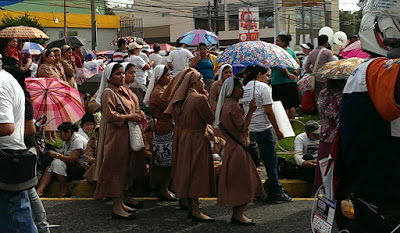Reflections on the beatification of Oscar Romero
I had the good fortune to attend the beatification ceremony for martyred archbishop Oscar Romero celebrated by the Roman Catholic church in San Salvador on May 23. Three of us stood with hundreds of thousands of Salvadorans in the streets surrounding Plaza Salvador del Mundo as the church held up the life and example of the bishop who was the Voice for the Voiceless.
As Carlos Colorado sums up in his blog:
And then, there is the impression the event made on those who attended, and even those who experienced it remotely or learn about it later on. The grandeur and spectacle of the event will loom large in the popular imagination. It was, as presidential spokesman Eugenio Chicas said, “the event of the century” for El Salvador. Little details, from the 30 minute-long procession of over a thousand priests and bishops entering the altar to the astonishing solar halo that dazzled onlookers by appearing precisely during the rite of beatification, seem to assure that the memory of the event will be seared in the historic memory as an eye-popping spectacle.
In the short term, these feel-good atmospherics will generate positivity and good will. But they will also generate expectations and not all of those expectations will be fulfilled.So what did it all mean?
For the Roman Catholic church, Romero's beatification certainly reflects the emphasis of Pope Francis who wants his church to focus on serving the poor throughout the world. The Catholic social justice tradition which has not received top billing from the Vatican in recent decades, now has a prominence epitomized by Romero. The personal intervention of the first Latin American pope moved Romero's cause from a slow crawl to the fast track.
For El Salvador, Romero's beatification is part of the consolidation of post war gains. Romero was assassinated by a right wing oligarchy who could not bear his message that the poor and down-trodden had human rights and were worthy of dignity. But now El Salvador has its second peacefully elected left wing government in a row, and the beatification was a national celebration of Romero's message over and against those who tried to silence it with an assassin's bullet. (Of course not all are unified behind this message, as symbolically seen in the short-lived renaming of a street in San Salvador this year for the man who ordered the assassination, Roberto D'Aubuisson).
For people who struggle for social justice throughout Latin America, the beatification was a chance to remember the example of a person who had long been a martyr and a saint in their eyes regardless of whether the church had formally recognized him as such. "San Romero de las Americas" was finally receiving the official recognition from his church which those struggling for justice had given him all along.
For hundreds of street vendors, the beatification ceremonies were a chance to eek out a living. Some hawked bottles of water, others jewelry or T-shirts or posters, others sold dulces or tortillas or pupusas. They are part of the hundreds of thousands of poor Salvadorans who labor daily in the informal economy. Oscar Romero, with his open heart for the poor, would have been walking side by side with them, more comfortable sharing their burdens than in the ornate trappings of a beatification ceremony attended by princes of the church and heads of state.
It is fitting to conclude with words from one of Romero's homilies:
We have never preached violence except the violence of love, which left Christ nailed to a cross,
The violence that we must each do to ourselves
to overcome our selfishness
and such cruel inequalities among us.
The violence we preach is not the violence of the sword,
the violence of hatred.
It is the violence of love,
of brotherhood,
the violence that wills to beat weapons
into sickles for work.
NOVEMBER 27, 1977, English translation in The Violence of Love.
More from the beatification ceremony on May 23, 2015:
Video of the event.
Texts of the ceremony
Photo gallery from El Faro.
Some of my photos:
 |
| The faithful gathered for the ceremony |
 |
| More than 1000 priests processed to the plaza. |
 |
| A statue of Romero stood amidst the crowds |
 |
| Hundreds of thousands gathered in San Salvador |
 |
| An image of Romero on the telephone company building and a banner from Christian Base Communities organization denounced conservative elements in the church. |
 |
| A halo appeared around the sun at the height of the beatification ceremony |
 |
| A new image of the Blessed Romero was unveiled. |
Comments
George Mangarelli
St. Jude Parish, Allen,TX